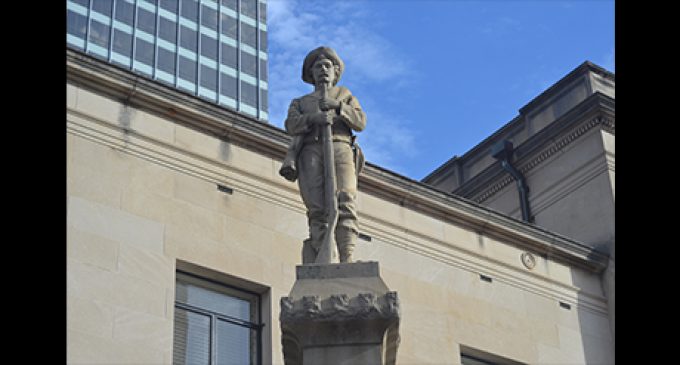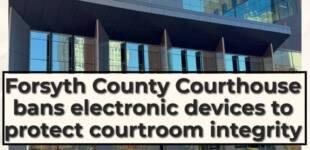Where do Confederate Monuments Belong?

By Jon Hyland
When I moved to Winston-Salem 12 years ago, I only knew some of my family history here. I took pride in my Moravian heritage because I loved the sugar cake and illuminated paper stars. I knew there were Confederate soldiers too, but that seemed like the distant past.
When my mother passed away, she left a box of memorabilia including a Winston-Salem Journal article from Nov. 19, 1973, titled “Monument Relocation Considered.” From this article, I learned that my great-great-grandfather, Dr. James A. Blum, drew up the design for Winston-Salem’s Confederate monument. According to the same article, his daughter, Bessie Blum, unveiled the statue at a celebration on Oct. 3, 1905. Since then, I’ve learned that other reports identified Thomas Delahunty of Philadelphia as the designer of the statue. Not knowing this, I accepted my family’s connection to the statue, but didn’t dwell on it. I simply regarded it as a remnant of history. On August 12, 2017, I was shocked and saddened by the news that various white supremacist groups had gathered in Charlottesville to protest the removal of a Robert E. Lee statue, and that one militant deliberately drove into a crowd and killed a counter-protester, Heather Heyer. Yet, somehow, I still didn’t consider the question of what to do with our Confederate monument pressing, or reflect on the statue’s impact on our community.
Four months later, a friend casually asked me what I thought we should do with the monument.
The answer came easily—contextualize. All I needed was someone to ask me.
As a graphic designer who has studied how monuments function, I was familiar with the dubious claim that they help us remember history. Instead, monuments ask us to hold a singular point of view on one idea of the past, arguably hindering our access to history. So my first thought was that we should leave the monument, but put something next to it condemning slavery and highlighting how roughly 179,000 black soldiers fought for the Union Army, 40,000 of whom died during the Civil War. That seemed reasonable enough — until I read about the memorial’s dedication ceremony.
According to the Winston-Salem Journal, the keynote speaker at the unveiling, Lt. Col. Alfred Moore Waddell, stated the purpose of the monument was to “counter the commonplace notion the Confederates were ‘ignorant, barbarous, cruel traitors’ who without a glimmer of justification ‘sought to destroy the best government under the sun, and deluged a continent in blood.’”
Seven years prior, Waddell said in a campaign speech for North Carolina Democrats, “We will never surrender to a ragged raffle of negroes, even if we have to choke the Cape Fear River with carcasses.” On Nov. 10 of that same year, he led a group of vigilantes in the Wilmington Race Riot of 1898, violently terrorizing blacks to keep them from voting, and successfully running out those who were elected.
The fact that Waddell was asked to be the keynote speaker at the unveiling makes it very clear the monument’s primary purpose was to impress fear upon the black community. Even if we provide this context—with a plaque, additional artwork, or spray paint—preserving the statue’s monumental status atop a pedestal downtown only helps to hide its agenda in plain sight, and complicates what should be straight-forward.
Let’s set a different tone in Winston-Salem. There is no denying this memorial sanctions the oppression and mistreatment of people of color. Removing this hurtful symbol from its current location and placing it in a history museum—along with a description of slavery in N.C., an account of all peoples who fought and died in the Civil War, and a history of the Jim Crow South—is the most truthful, and therefore honorable, way to remember our past. It’s also an important gesture that signals to everyone that we understand our history, and we’re ready to put our best foot forward. Let’s take a stand on this issue as caring citizens, but ask our business, religious, and academic institutions to let their positions be known as well.
If you are planning to attend any rallies near the monument in the coming days, there’s a chance you’ll see me there. I kind of look like the Confederate soldier. I won’t be shouting anything. I’ll be watching, listening, and waiting, confident we’ll do the right thing together.
Jon Hyland is a designer and artist living in Winston-Salem, NC. For more than a decade, he has helped organizations with social missions develop their identities and tell their stories through a variety of media, including print, web and video. Jon has served on the boards of The Shalom Project and Neighbors for Better Neighborhoods. He has also taught graphic design at Salem College.








